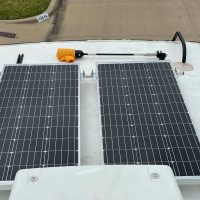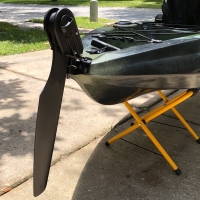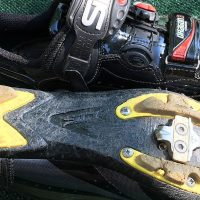
Dedicated GPS or Smartphone?
Why a dedicated GPS (DGPS) is far better than any SmartPhone ever will be!
Frequently this topic keeps coming up over and over again, and I thought it was about time to lay out my thoughts on the subject. I'm not advocating a single source for navigation, just why a DGPS is far more reliable than a Smartphone. ALWAYS, always have a backup plan!
Why a dedicated GPS (DGPS) is far better than any SmartPhone ever will be!
 Anyone traveling to remote areas where cellular coverage is limited or unavailable will get more accurate information because dedicated GPS devices connect to the satellite network more consistently and more frequently. Smartphones use triangulation from cell towers before using GPS satellites to compute your current location which is far less accurate. A dedicated GPS will ping a dedicated satellite far more frequently to provide more accurate altitude readings, recorded mileage, speed, and changes in elevation down to 3 feet in some cases.
Anyone traveling to remote areas where cellular coverage is limited or unavailable will get more accurate information because dedicated GPS devices connect to the satellite network more consistently and more frequently. Smartphones use triangulation from cell towers before using GPS satellites to compute your current location which is far less accurate. A dedicated GPS will ping a dedicated satellite far more frequently to provide more accurate altitude readings, recorded mileage, speed, and changes in elevation down to 3 feet in some cases.
A DGPS uses real topo map information to tell you ahead of time about topographical features that could impede your trek, whether it’s canyons, mountains, rivers, or other hurdles.
A DGPS device does not need a cell network for maps, recalculating your route, turn by turn (even on trails), points of interest locations, or a data plan.
A DGPS is more durable, waterproof, has better battery life, replaceable batteries, and are built to be rugged and withstand the elements of the outdoors. Smartphones are not built specifically for outdoor activities. Humidity, rain, harsh terrain, drops, and other wear and tear from the trails may be enough to render one useless.
Tech Time: Cell phones only ping an actual satellite to verify the triangulation information for location, even when a GPS type app is used.
There are currently only 32 GPS satellites in orbit worldwide owned by the US Government, and the satellites grid was just fully operational in 1995 with the first 24. The Russians have its GLONASS system, the European Union has its Galileo system, and China has its BeiDou system. Currently, GLONASS is the only other system that offers worldwide coverage. GPS satellites only last about 10 years, and often need servicing during their lifetime, which is why there are currently 32 in orbit, but it only takes 24 to cover the globe, the rest are basically backups.
GPS Pinging is not the only purpose for these satellites. They are a military owned and operated piece of equipment used by the US Military for their own purposes. A GPS can only get a ping reading when and only when the GPS is available to give it.
 A standard GPS receiver listens to a particular frequency for radio signals, while the satellites send time coded messages at that same frequency. Each satellite has an atomic clock and transmits the current exact time as well. The GPS receiver figures out which satellites it can hear, and then starts gathering those messages. The messages include time, current satellite positions, and a few other bits of information. The message stream is slow - this is to save power, and also because all the satellites transmit on the same frequency, they're easier to pick out if they go slow. Because of this, and the amount of information needed to operate well, it can take 30-60 seconds to get a location on a regular GPS. When it knows the position and time code of at least 3 satellites, a GPS receiver can assume it's on the earth's surface and get a good reading. 4 satellites are needed if you are not on the ground and you want altitude as well. So, remember this 30-60 a ping for a standard GPS.
A standard GPS receiver listens to a particular frequency for radio signals, while the satellites send time coded messages at that same frequency. Each satellite has an atomic clock and transmits the current exact time as well. The GPS receiver figures out which satellites it can hear, and then starts gathering those messages. The messages include time, current satellite positions, and a few other bits of information. The message stream is slow - this is to save power, and also because all the satellites transmit on the same frequency, they're easier to pick out if they go slow. Because of this, and the amount of information needed to operate well, it can take 30-60 seconds to get a location on a regular GPS. When it knows the position and time code of at least 3 satellites, a GPS receiver can assume it's on the earth's surface and get a good reading. 4 satellites are needed if you are not on the ground and you want altitude as well. So, remember this 30-60 a ping for a standard GPS.
On to cell phones: To save costs, most cell phones share the GPS receiver components with the cellular components, and you, therefore, can't get a fix and talk at the same time. Since people don't like that and it’s the lowest form of GPS hardware available, the cell companies will use their own technology in the following way:
Your cell phone will get most of the information from the cell company and towers to feed to the GPS receiver. Some of this is gross positioning information based on what cellular towers can 'hear' your phone, so by this time they already know your location to within a city block or so through triangulation. Your cell phone will then switch from cellular to GPS for a split second and collect the raw GPS data from 3 satellites (mind you at random intervals set by the US Government and honored by the cell companies), and then switch back to cell mode. The cell then sends the raw GPS data to your cell company where your cell company processes that data (acting like an offline GPS receiver) and sends the location back to your phone for your phone and apps to use. Shew-wee!
This saves a lot of money in the phone design and takes the load off the 24 GPS satellites. But this does have a heavy load on cellular bandwidth, and with a lot of requests coming it requires a lot of fast processing servers to manage all that data. Let's put this in perspective: Total DGPS sales in 2015 topped at about 40 million units. Of this, 36 % were Portable Outdoor units (~14.4m). Cell phones topped 1.45 billion in 2015! Still, overall the cell companies can be cheaper and quicker to implement. They are reluctant, however, to release full GPS based features on cell phones due to the expense and the load that many devices would put on the 24 satellites would just shut them down - period! And that's why a Cell Phone can't use the GPS Stsyem completely and why they are heavily regulated by the FCC.
Still with me so far? Now that you know what you know, and you know that the requests are regulated and you know that towers, bandwidth, and cell company communication is heavily relied on for locations - what happens when you get into poor services areas or areas with no service at all? The only thing left for your phone to use is the GPS satellites with the very limited long intervals!

Now as technology progresses, data packets get smaller, and transmissions faster, new towers are built, cell phones will still use GPS satellites to track location, but they will rely on them less and less. But, and this is a big but, GPS satellite pinging is still regulated by the different governments on how often a single device can ping their satellites. Even DGPS receivers have a designated interval in which they are allowed to ping a satellite. This interval is far shorter than a cell phone because they don’t have any other source of data but still regulated. Take for example a dedicated Cycling GPS, the best of the best Garmin has ($600) the Edge 1030, Garmin will always tell you that adding a compatible Speed Sensor to one of your wheels will “fill in the gaps” and provide much more speed and distance accuracy, very similar to what cell towers are doing.
In conclusion: If you are out in the Outdoors and you are "relying" on a device for your travels and location, do not count on your cell phone to provide that data - it just might get you killed!







